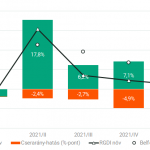
Social and business innovations: linked in practice – but two worlds apart in theorising?
Attila Havas
Many social innovations can only be successful when supported by various types of business innovations, be they technological and non-technological ones. While both business and social innovations have been studied for several decades, these two communities still live in their fiefdoms. More interactions are needed between these two ‘tribes’ for mutual learning.
As a first step, a few lessons from business innovation studies are highlighted below.
Introduction
Thorough case studies – e.g. those on social housing and fresh water supply (Schimpf et al., forthcoming, Schimpf and Ziegler, forthcoming) – clearly indicate that in many cases social innovations can only be successful when supported by various types of business innovations, be they product, process, management, organisation, business model or market innovations. Both business and social innovations have been studied for several decades by now. Yet, these two communities still seem to live in their own fiefdoms. This review is aimed at stressing the need and possibilities for more interactions and exchanges between these two ‘tribes’. As a first step, lessons from business innovation studies are highlighted below, indicating opportunities to refine the analytical tools and methods we use, and thus improve our understanding of social innovation processes. These insights – on the degree of novelty, level of change, the ‘dark side’ of innovation, policy rationales to justify interventions, and policy implications – can be useful for practitioners, social innovation scholars, policy analysts and policy-makers.
What to expect from social innovation?
Business innovation – conducted by companies with the aim of improving performance, and thus increasing profits – has been a key issue for researchers, policy analysts, and policy-makers for decades. Although many policy-makers, journalists, researchers and other opinion leaders tend to think of innovation as a ground-breaking technological idea, the modern literature on business innovations is based on a different understanding. First, innovation is not an idea, but a solution introduced to the market, that is, an idea with a proven practical use. Second, not only ‘world class’ new solutions are defined as innovations; these new solutions are distinguished by their degree of novelty: a solution can be new (i) to the firm introducing it, (ii) to a given market (that is, not only to the firm introducing it, but to a given country or region), and (iii) to the world. These considerations are relevant for social innovation practitioners and policy-makers, too.
The literature on business innovation stresses the need to identify the subject (or level) of change and has developed relevant notions to perform detailed analyses (product and process innovations, technological systems, techno-economic paradigms). (Freeman, Perez, 1988) Social innovation researchers, however, define the unit of analysis (level of change) differently, from changes at the micro through mezzo level to the society as a whole. (for example Heiskala, 2007; Moulaert et al., 2013; for a review of definitions: Edwards-Schachter, Wallace, 2017) This is not to be confused with the degree of novelty. Both for social innovation practitioners and policy-makers, it is also of crucial relevance to have a clear objective as to the nature of change is aimed at (e.g. organisational, institutional, and/or technological), at what level.
The ‘dark side’ of innovations
Business innovations do not always bring positive changes. The obvious examples are lock-in in inferior technological trajectories (Arthur, 1989; David, 1985); the negative health and environmental consequences of widespread motorisation (Barker (ed.), 1987); planned obsolescence intentionally limiting the life-span of particular consumer goods (Calvano, 2007); and the so-called financial innovations introduced in the name of ‘dispersing the risk’, but in essence allowing a few, well-informed and well-positioned actors to gain substantial profits while putting a huge burden on society as a whole (Soete, 2013). Social innovation may also have a ‘dark side’. Clearly, no society is homogenous, not even those members of it, who are marginalised and disempowered: they still have their own values and views, and thus might perceive a certain change process and its effects in different ways. Moreover, a particular policy measure or another solution that improves the situation of some groups can, in fact, affect other groups negatively – and not because they perceive it that way, but as an actual (‘neutrally/ objectively measurable’) impact. This needs to be considered by social innovation policy-makers when devising interventions and specific policy tools.
Market and systemic failures: why to intervene?
Economics paradigms treat business innovation in diametrically different ways: they consider different notions as crucial ones, offer diverse justifications (policy rationales) for state interventions, interpret the significance of various types of inputs, efforts, and results differently, and thus – implicitly – identify different ‘targets’ for measurement, monitoring and analytical purposes: what phenomena, inputs, capacities, processes, outcomes and impacts are to be measured and assessed.
Mainstream economics justifies interventions with the market failure argument in this policy domain, too: firms invest in R&D activities below the socially optimal level, because the results achieved by those firms that devote their own resources to generate new knowledge, without state intervention would eventually become available also for those competitors, which spare these expenses. These latter firms, in turn, would enjoy unfair advantages in market competition. This implies that a strong intellectual property rights (IPR) regime is a must to boost private investment into R&D. This policy approach is unlikely to be an appropriate one to promote social innovation. Social innovators do not incline to charge licence fees for those who would like to introduce these new solutions, addressing the same or similar societal problem, in other contexts. Gaining the recognition of being a creative social innovator is likely to be a stronger driver than collecting revenues from selling IPR. Further, several technologies, originally developed for business purposes, might be useful for social innovations. When these technological solutions are protected by IPR, opportunities for amending these to become elements of social innovations, are severely restricted. Overall, social innovation policies should rather promote the dissemination and exploitation of knowledge to foster social innovation than constrain these processes.
Evolutionary economics of innovation claims that the properties of an innovation system determine how knowledge is generated, diffused and exploited. Some features of the system can hamper innovation activities and thus the system failure concept postulates that there are systemic reasons behind an unsatisfactory innovation performance. It is, therefore, not sufficient just trying to “set the incentives right”; these systemic reasons should be identified and then tackled by carefully devised policy measures. This approach can be extended to social innovation without any theoretical constraint. While it is indeed a demanding task to establish what elements of an innovation system are missing or fledgling, what institutions (‘rules of the game’) hamper social innovations, and thus what policy actions would be appropriate to induce the necessary changes, these analytical efforts cannot be spared if social innovation policy-makers strive for devising effective policy measures.
Further, evolutionary economics is concerned with several key notions that could be relevant when analysing social innovation and devising policy tools: the importance of dynamics; uncertainty; differences among contexts; learning; various types, forms and sources of knowledge; path dependence; processes of generating variety; selection among diverse solutions; networking and co-operation among actors; and co-evolution of various types of changes. (Dosi and Nelson, 2010; Fagerberg et al. (eds) 2005)
Social innovations draw on various types (scientific and practical) and forms (codified and tacit) of knowledge, stemming from different sources (organised and systematic R&D activities, as well as other types of search processes, e.g. those ‘informed’ by practitioners). Diversity is, therefore, a key notion. To devise appropriate policy tools, policy-makers need to recognise the diversity of social innovations, in terms of their nature, drivers, objectives, actors, knowledge bases, and process characteristics.
Orchestration of policies influencing social innovation
Just as for business innovations, framework conditions for social innovations are of crucial relevance. Yet, as social innovation policy-makers cannot influence these factors, they need to orchestrate their efforts with those decision-makers, who devise policy measures that affect framework conditions for social innovation. Empowerment and capacity building are crucial for social innovation, and clearly influenced by a number of policy domains, including education and culture, labour market and employment, social care and social housing, regional development, health, and taxation policies, as well as regulations on setting up and closing down businesses.
Intertwined social and business innovations
It is a widely used practice in the social innovation research community to juxtapose social and technological innovations. The case of social housing, however, vividly illustrates that various types of innovations – including technological, organisational, financial, business model and market innovations – are needed to tackle the challenge of providing affordable housing at an acceptable level of comfort, hygiene and safety for those in need. These types of innovations can be introduced either by the social innovators themselves or by other actors, whose main aim is to make profits. Hence, it is more fruitful to distinguish between the underlying objectives of a given innovation (addressing a societal challenge vs. making profits).
Building a large number of flats for social housing – as opposed to building palaces for the aristocrats, villas for well-off business people or just elegant flats for the better-off clients – required many different types of changes. (Box 1)
| Box 1: Types and examples of innovations necessitated by social housing ▪ New, cheaper, mass-produced building materials, including bricks and so-called pax bricks, new types of glass, iron and concrete as building materials, flooring, tiles, windows, doors, fittings for kitchens, bathrooms and toilets; ▪ New business models for companies producing building materials; ▪ New modes of logistics to ship building materials in huge volumes; ▪ New approaches in architecture when designing blocks of flats for social housing; ▪ New or significantly modified processes and building techniques (e.g. steel casting, iron trellis construction, glass columns), tools, and equipment to build these blocks of flats, as well as the adoption and adaptation of a set of new technologies originally developed for industrial buildings; ▪ New co-operative working methods at construction sites; ▪ New, more efficient heating technologies; ▪ Improved infrastructure; ▪ New organisations for self-help (guilds in Vienna, other initiatives in Germany, as well as those offering technical expertise and advice); ▪ New types of mass-produced furniture, lamps, kitchen ware, carpets, curtains, and so on, to furnish these flats; ▪ Setting up new companies to service these new demands and introducing and following new business models by established companies; ▪ New funding modes. |
To sum up, social housing as a social innovation has co-evolved with a range of technological, organisational, business model, financial, and market innovations – each shaping each other. Social innovators themselves developed some of these innovations, while profit-seeking business actors introduced other ones – hence social and business innovations have co-evolved. (Providing fresh water also requires interconnected social and business innovations, Schimpf and Ziegler, forthcoming).Using modern terminology, social housing can be understood as a challenge-driven innovation and, thus, the policies supporting these processes as challenge-driven innovation policies.
Theoretical and policy implications
The prevalent dichotomy of social vs. technological innovation needs to be reconsidered. It is more instructive and productive – both for social innovation practitioners and social innovation policy-makers – to understand social innovation as a co-evolutionary process of social innovation and all the business innovations, including both technological and non-technological ones, that are necessary to achieve the desired social changes.
Social innovations, therefore, need to be considered in science, technology, and innovation (STI) policy-making processes as well, not only by social innovation policy-makers. In line with this, three ‘facets’ of social innovation policy-making can be identified:
(1) Social innovation policy can be considered as a separate policy domain related to social policy aiming at providing new solutions to societal challenges such as marginalisation. For example, developing a solution to help poor, unskilled, unemployed people to become self-employed or set up their own businesses would fall under this category.
(2) Social innovation policy can be regarded as a legitimate sub-field of STI policies comprising policy measures in support of those involved in social innovation processes, independently of the actors (profit–oriented firms or non-for-profit organisations). An example could be funding social innovation projects which aim at co-creating and testing new social housing models by involving firms from the respective sectors, municipalities, citizens in general, prospective tenants, in particular, as well as researchers from various fields of science and technology.
(3) Social innovation policy can also assume the role of a sub-field of economic policy-making, in which only firms are being considered as solution providers to societal challenges when designing policy tools. For example, entrepreneurs might be offered tax incentives to introduce profitable models of housing, running at the lowest cost for municipalities and tenants.
For social-innovation-policy as part of social policy, the experience accumulated through business innovation policy-making can be exploited in several respects. First, lessons can be drawn in relation to the understanding of the functions and failures of innovation systems, as well as concerning the importance of involving users and customers in innovation processes (user-led innovation). Second, invention should not be confused with innovation: social innovation policy measures should be designed in a way that ideas meant to address societal challenges should become implemented through the social innovation process, that is, leading to the successful introduction and diffusion of social innovation.
For those cases, in which social innovation may be considered as a sub-field of STI policies, policy-makers need to pay more attention to (a) the interactions between business and social innovations; (b) frugal innovation, which aims at solutions for poor customers; as well as (c) inclusive innovation, aimed at inclusive economic growth, and in the meantime at involving various stakeholders in the innovation processes, thereby mobilising a diverse set of knowledge and experience.
A new type of justification for STI policies is also emerging, based on the bold ambition that besides correcting market and/or systemic failures, policies should also aim at creating new opportunities and new markets. (Cagnin et al., 2012; Foray et al., 2012; Mazzucato, 2016; Mowery et al., 2010) The basic idea of challenge-driven and market-creating STI policies might provide a useful starting point for social innovation policy-making, on the one hand, and might also make it easier to accept that STI policies should consider social innovation, too, as a legitimate ‘target’, on the other.
References
This post draws on the contribution of the author to von Jacobi et el. (forthcoming).
Arthur, B. (1989): Competing Technologies, Increasing Returns and Lock-In by Historical Events, Economic Journal, 99 (March): 116–131
Barker, T.C. (ed.) (1987): Economic and Social Effects of the Spread of Motor Vehicles, Basingstoke: MacMillan
Cagnin, C., Amanatidou, E., Keenan, M. (2012): Orienting European innovation systems towards grand challenges and the roles that FTA can play, Science and Public Policy, 39 (2): 140–152
Calvano, E. (2007): Destructive Creation, SSE/EFI Working Paper Series in Economics and Finance, No. 653
David, P.A. (1985): Clio and the Economics of QWERTY, American Economic Review, 75 (2): 332–337
Foray, D., Mowery, D.C., Nelson, R.R. (2012): Public R&D and social challenges: what lessons from mission R&D programs?, Research Policy, 41 (10): 1697–1702
Edwards-Schachter, M., Wallace, Matthew L. (2017): ‘Shaken, but not stirred’: Sixty years of defining social innovation, Technological Forecasting & Social Change, 119: 64–79
Dosi, G., Nelson, R.R. (2010): Technical Change and Industrial Dynamics as Evolutionary Processes, in: Hall, B.H., Rosenberg, N. (eds): Economics of Innovation, pp. 51–127, Amsterdam: North-Holland
Fagerberg, J., Mowery, D.C., Nelson, R.R. (eds) (2005): The Oxford Handbook of Innovation, Oxford: Oxford University Press
Freeman, C., Perez, C. (1988): Structural crises of adjustment, business cycles and investment behaviour, in: Dosi, G., Freeman, C., Nelson, R.R., Silverberg, G., Soete, L. (eds): Technical Change and Economic Theory, pp. 38–66, London: Pinter
Havas, A. (2016): Recent economic theorising on innovation: Lessons for analysing social innovation, CrESSI Working Papers, No. 27/2016, http://eureka.sbs.ox.ac.uk/id/eprint/7060
Heiskala, R. (2007): Social innovations: structural and power perspectives, in: Hämäläinen, T.J., Heiskala, R. (eds): Social innovations, institutional change and economic performance, pp. 52–79, Edward Elgar, Cheltenham
Mazzucato, M. (2016): From market fixing to market-creating: a new framework for innovation policy, Industry and Innovation, 23 (2): 140–156
Moulaert, F., MacCallum, D., Hillier, J. (2013): Social innovation: intuition, precept, concept, theory and practice, in: Moulaert, F., MacCallum, D., Mehmood, A., Hamdouch, A. (eds): The International Handbook on Social Innovation: Collective Action, Social Learning and Transdisciplinary Research, pp. 13–24, Cheltenham: Edward Elgar
Mowery, D.C., Nelson, R.R., Martin, B.R. (2010): Technology policy and global warming: why new policy models are needed (or why putting new wine in old bottles won’t work), Research Policy, 39 (8): 1011–1023Nicholls, A., Simon, J., Gabriel, M. (2015): Introduction: Dimensions of Social Innovation, in: Nicholls, A., Simon, J., Gabriel, M. (eds): New frontiers in social innovation research, pp. 1–26, Basingstoke: Palgrave Macmillan
Schimpf, G-C., Mildenberger, G., Giesecke, S., Havas, A. (forthcoming): Trajectories of Social Innovation: Housing for All?, in: Nicholls, A., Ziegler, R. (eds): Creating economic space for social innovation, ch. 5, Oxford: Oxford University Press
Schimpf, G-C., Ziegler, R. (forthcoming): Trajectories of Social Innovation: Water for All?, in: Nicholls, A., Ziegler, R. (eds): Creating economic space for social innovation, ch. 6, Oxford: Oxford University Press
Soete, L. (2013): Is Innovation Always Good?, in: Fagerberg, J., Martin, B.R., Andersen, E.S. (eds): Innovation Studies: Evolution and Future Challenges, pp. 134–144, Oxford: Oxford University Press
von Jacobi, N., Nicholls, A., Edmiston, D., Havas, A., Kubeczko, K., Molnár, Gy., Mildenberger, G., Schimpf, G-C (forthcoming): Social Innovation Policy, in: Nicholls, A., Ziegler, R. (eds): Creating economic space for social innovation, ch. 16, Oxford: Oxford University Press
Nem található esemény a közeljövőben.
A KRTK Közgazdaság-tudományi Intézet teljesítményéről A KRTK KTI a RePEc/IDEAS rangsorában, amely a világ közgazdaság-tudományi tanszékeit és intézeteit rangsorolja publikációs teljesítményük alapján, a legjobb ... Read More »

Tisztelt Kollégák! Tudományos kutatóként, intézeti vezetőként egész életünkben a kutatói szabadság és felelősség elve vezetett bennünket. Meggyőződésünk, hogy a tudomány csak akkor érhet el ... Read More »

Srí Lanka: a 2022-es gazdasági válság leckéje – A. Krueger Lessons from Sri Lanka Anne O. Krueger Jul 25, 2022 – Project Syndicate ... Read More »

A permanens válság korában élünk – J. Meadway We’re living in an age of permanent crisis – let’s stop planning for a ‘return ... Read More »

A 2021 végén, illetve 2022 elején tapaszalt 6, illetve 7%-os cserearányromlás brutális reáljövedelem-kivonást jelentett a magyar gazdaságból. A külső egyensúly alakulásával foglalkozó elemzések többnyire ... Read More »
